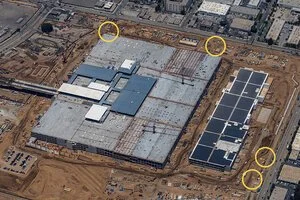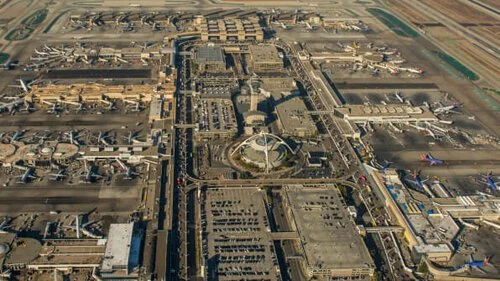$14 Billion Dollar Modernization Program at LAX
LAX Lamp Project
Los angeles, CA
BACKGROUND
According to Los Angeles World Airport data (LAWA), 88 million people traveled through the Los Angeles airport in 2019 making LAX the second busiest airport in the United States and fourth busiest in the world. In response to its increasing passenger volume, LAX is in the midst of a $14 Billion dollar overhaul to its terminals, airfield, and landside access. The project is called the LAX Modernization Program, and is considered the largest public works project in the history of the city of Los Angeles.
A Fluor-led joint venture called LAX Integrated Express Solutions, or LINXS, was contracted by LAWA to design-build, finance, operate and complete the Modernization Program.
The joint venture includes notable partners such as:
Fluor Corp.
Balfour Beatty
ACS Infrastructure Development Inc.
Dragados USA
Hochtief PPP Solutions
Flatiron Construction Corp.
Bombardier Transportation
The LAX Modernization Program was initiated in 2013 and already completed infrastructure and renovation upgrades include: the new Tom Bradley International Terminal, the Great Hall, the Airport Response Coordination Center, the LAFD Aircraft Rescue and Firefighting Station No. 80, in addition to new aircraft gates, concourses, taxiways, taxilanes, and replacement of the Central Utility Plant.
Current Projects include: the Landside Access Modernization Program (LAMP), Terminals 1 & 7 Renovation, Midfield Satellite Concourse, the Curbside Appeal Project, and additional runway construction.
LAMP IMPROVES ACCESSIBILITY TO LAX
An estimated 50% of travelers arriving at LAX arrive by car and drop off travelers at the Central Terminal Area. Cars must circumnavigate a roadway known as the ‘horseshoe’ which wraps around the Central Terminal Area. This segment of the journey often takes motorists over an hour to complete. The number of vehicles is expected to increase as annual passenger volume continues to break records. The Landside Access Modernization Program (LAMP) was created to address this congestion and to provide access to the Central Terminal Area by public transportation.
The Landside Access Modernization Program is divided into five major program components: an Automated People Mover (APM), a Consolidated car rental center, and roadway improvements, and two Intermodal Transportation Facilities for additional parking, shipping, and ground transportation services. The largest component of the Landside Access Modernization Program is the $5.5 billion dollar Automated People Mover (APM) that is being constructed to remedy traffic congestion, provide easier accessibility to the airport, improve the airport’s carbon footprint, and prepare for the 2028 Olympics that will be hosted in Los Angeles.
The APM will consist of a 2.25 mile elevated electric train that is designed to provide reliable and affordable access to the Central Terminal Facilities. The APM is built to be efficient and environmentally responsible. The system will operate 44 electric powered train cars which will include regenerative braking to reduce power consumption, and will be made from materials which are 98% recyclable after their service life. In addition, the nearby LEED Gold Certified command center will generate over half of the consumed energy from solar sources. The train system will have nine stops, including 6 stations connecting the three terminals, the Consolidated Rent-A-Car (ConRAC), the regional light rail and transit system, offsite parking facilities, and new drop-off/pickup locations. The project which broke ground in 2019 is expected to be passenger ready in 2023.
CONSOLIDATED RENT-A-CAR FACILITY - WORLD’S LARGEST RENTAL CAR FACILITY
The high volumes of travelers passing through the LAX airport drives demand for transportation services. The area is the second busiest car rental market in the country, also contributing to the traffic congestion near the Central Terminal Area. LAWA approved a $2 billion dollar agreement to construct the Consolidated Rent-A-Car Facility (ConRAC). The 6.4-million-square-foot building will consolidate rental car companies in one convenient location to improve efficiency and reduce traffic congestion.
The massive ConRAC facility is the largest of its kind in the world and the second-largest concrete structure in the US, next to the Pentagon. A concrete batch plant was constructed onsite to provide 233,000 cubic yards of concrete to the project. Working at a steady pace, a full year was required to pour the building’s concrete foundation. One hundred twenty-nine thousand cubic yards were also poured for the Ready Return and 44,000 cubic yards for the Quick Turn Around buildings (light rental car maintenance area). The facility includes a solar farm that will generate an estimated 8,400 megawatt hours annually. ConRAC will store and operate 18,000 rental cars and the new facility will service hundreds of thousands of travelers renting cars annually with a rental car leaving ConRAC approximately every two seconds during peak times.
Construction is expected to be completed in 2023 alongside the APM project.
Fugitive Dust, Stabilized Construction Entrances, and FOD Control
The Fluor Joint Venture faces the challenges of orchestrating one of the largest public work programs in Californian history with multiple projects occurring simultaneously. Fluor JV must maintain an expedited schedule on or near an active airfield without disrupting airport operations.
As part of the Clean Air Act, any major ground disturbing related operations must submit a fugitive dust control plan to the South Coast Air Quality Management District and obtain a permit before operations begin. South Coast AQMD is a regulatory agency responsible for improving air quality in southern California by reviewing plans and enforcing the permit requirements. According to Rule 403 of the South Coast AQMD Rule Book, contractors of ‘large operations’ must use best practices to reduce fugitive dust including watering 3 times a day or paving construction access roads at least 100 feet onto the site to control potential PM10 and other fugitive dust emissions. The heavy construction traffic carrying prefabricated steel structures enter the site daily are one source of dust. An effective stabilized construction entrance must be able to withstand a high volume of traffic of the 60,000 loads while mitigating dust emissions.
Rule 403 requires the implementation of best available dust control measures (BACM) during active operations capable of generating fugitive dust. This rule also requires activities defined as “large operations” to notify the South Coast AQMD by submitting specific forms. A large operation is defined as any active operation on property containing 50 or more acres of disturbed surface area; or any earth moving operation with a daily earth-moving or throughput volume of 3,850 cubic meters (5,000 cubic yards), three times during the most recent 365 day period.
In addition to the dust control requirements, construction teams on both the APM and ConRAC projects must be mitigate sediment trackout to comply with NPDES stormwater permit requirements. The stabilized construction entrance/exit (TC-1) is designed to contain both sediment and debris on construction sites. As vehicles traverse through the egress and ingress points on the project, the sediment can be cleaned from the vehicle tires to avoid being deposited on active roadways.
Because the projects are located in near proximity to the airport, contractors must adhere to an additional set of development requirements and regulations within the Airport Airside, Airport Landside, and Airport Landside Support Subareas. One serious matter at airports is FOD (Foreign Object Debris) control. FOD must be eliminated before it can enter the airfield. Any type of FOD including construction dust, human created debris, trackout and materials can collide with or be ingested by aircraft engines causing safety risks and millions of dollars in damages annually. Contractors must account for all types of construction FOD making sure any debris tracked out of the job site will not enter the airside. Furthermore, both sites are surrounded by, adjoin or cross over major thoroughfares and airport roadways where trackout can be a risk to motorists and/or tracked out onto runways and taxilanes.
More About the FOD Prevention System
FOD Prevention Mats are easily transported, configured, installed, removed, and relocated to reduce FOD tracked from vehicle tires onto access roads and aircraft intersections. FOD Prevention Mats contain rows of alternating pyramids that are engineered to separate tire treads and dislodge debris. Sediment and debris collect at the base of the pyramids away from vehicle tires. The FOD Prevention Mat System can help to reduce foreign object debris (FOD) that is tracked onto active taxiways. FOD Prevention Mats can also contain sediment and debris that may be contaminated with PFAS or other hazardous substances.
FODS Mats can withstand weights in excess of 80 tons per mat, and are made from a durable polyethylene which make FODS easy to transport, move, relocate, and reuse. FODS include a 15 year UV inhibitor enabling applications on both short term projects and permanent installations.
FOD Prevention Mats are 100% made and sourced in the USA and can be completely recycled at the end of their 15 year lifecycle.
Originally designed as a reusable stabilized construction entrance, the effective design of the mats allows a wider application as is seen in the case of the Chennault International Airport. The mats can also be used to contain trackout from airport construction projects. The effective and low maintenance solution can contain debris without introducing rock or aggregate to the airfield.
Contact FODS today for more information.
844-200-3637
info@getfods.com.









